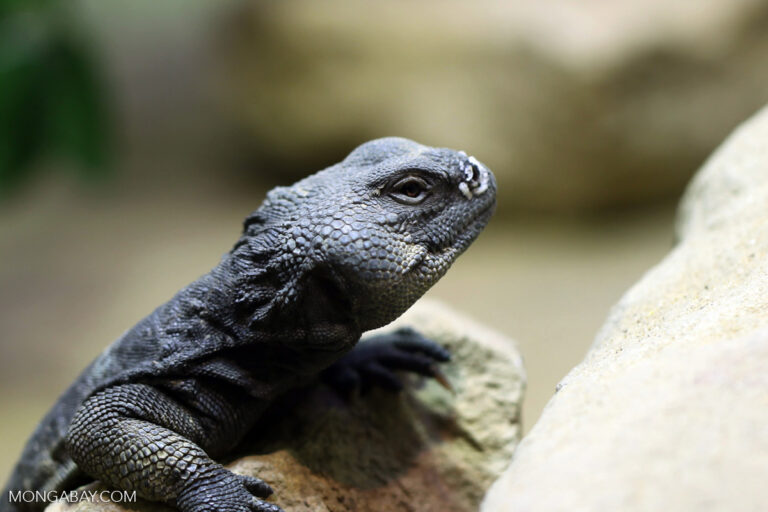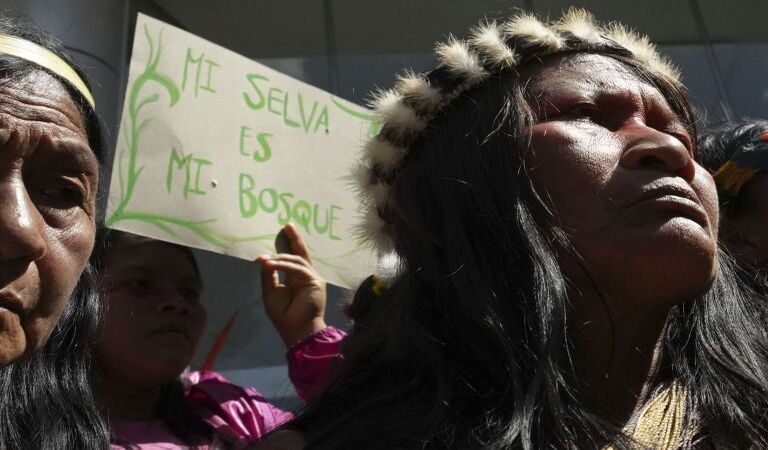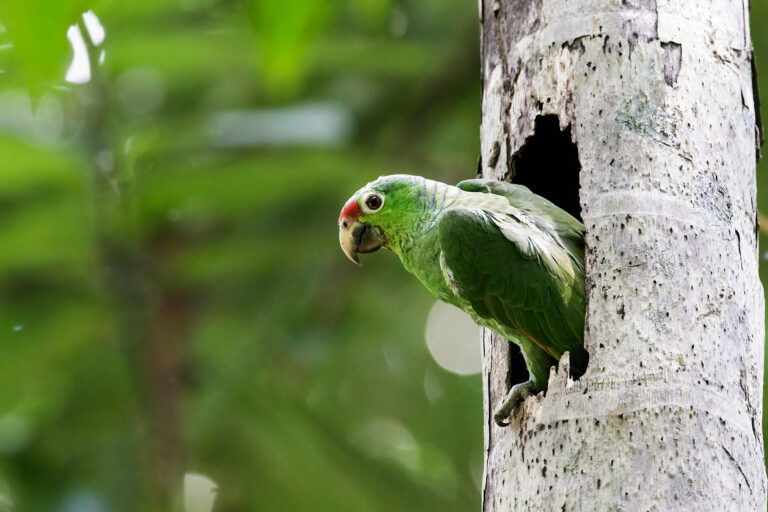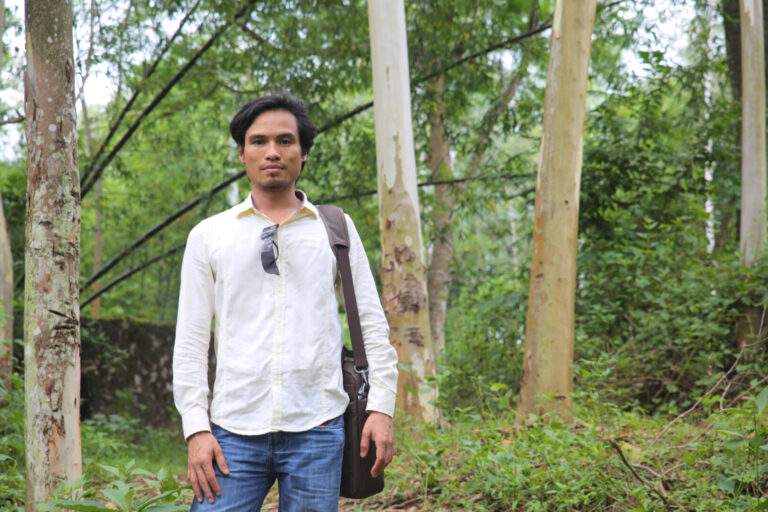- In 2018, Betty Rubio became the first woman president of her region’s Indigenous federation, a role in which she faces threats from narcotrafficking, logging and illegal mining.
- The Kichwa leader says her grandfather warned her about the risks of deforestation, so today she’s participating in an environmental monitoring project to detect illegal activities in the Amazon.
- In Peru, where only 4% of presidencies in Indigenous communities are held by women, Betty tries to encourage her female colleagues to take leading positions in their organizations.
Today, being an environmental defender in the Peruvian rainforest means challenging death. It means facing narcotrafficking, land encroachment, deforestation, and illegal logging and mining. It implies traveling hundreds of kilometers, for days, in rugged conditions and incommunicado, to detect these activities and risk life to defend the land.
And when the person leading the fight is a woman, the challenge is even greater.
“The hardest thing is leaving my kids [during trips to the communities]. The saddest thing is that most times there isn’t any [phone or internet] reception,” says Betty Rubio Padilla about the work she’s been doing for almost three years as the first woman president of the Federation of Native Communities of Medio Napo, Curaray and Arabela (Feconamncua), in the region of Loreto, Peru.
A mother of six, the leader’s voice breaks when she talks about the 46 trips she has taken to communities that are part of the federation. Those trips were particularly hard because three of her kids are schoolchildren who need her. “Once I was away for 24 days and I couldn’t stop thinking about my kids. Then my son tells me that in school they are telling him ‘your mom … is a fighter.’ He says he’s very proud and that makes me happy.”
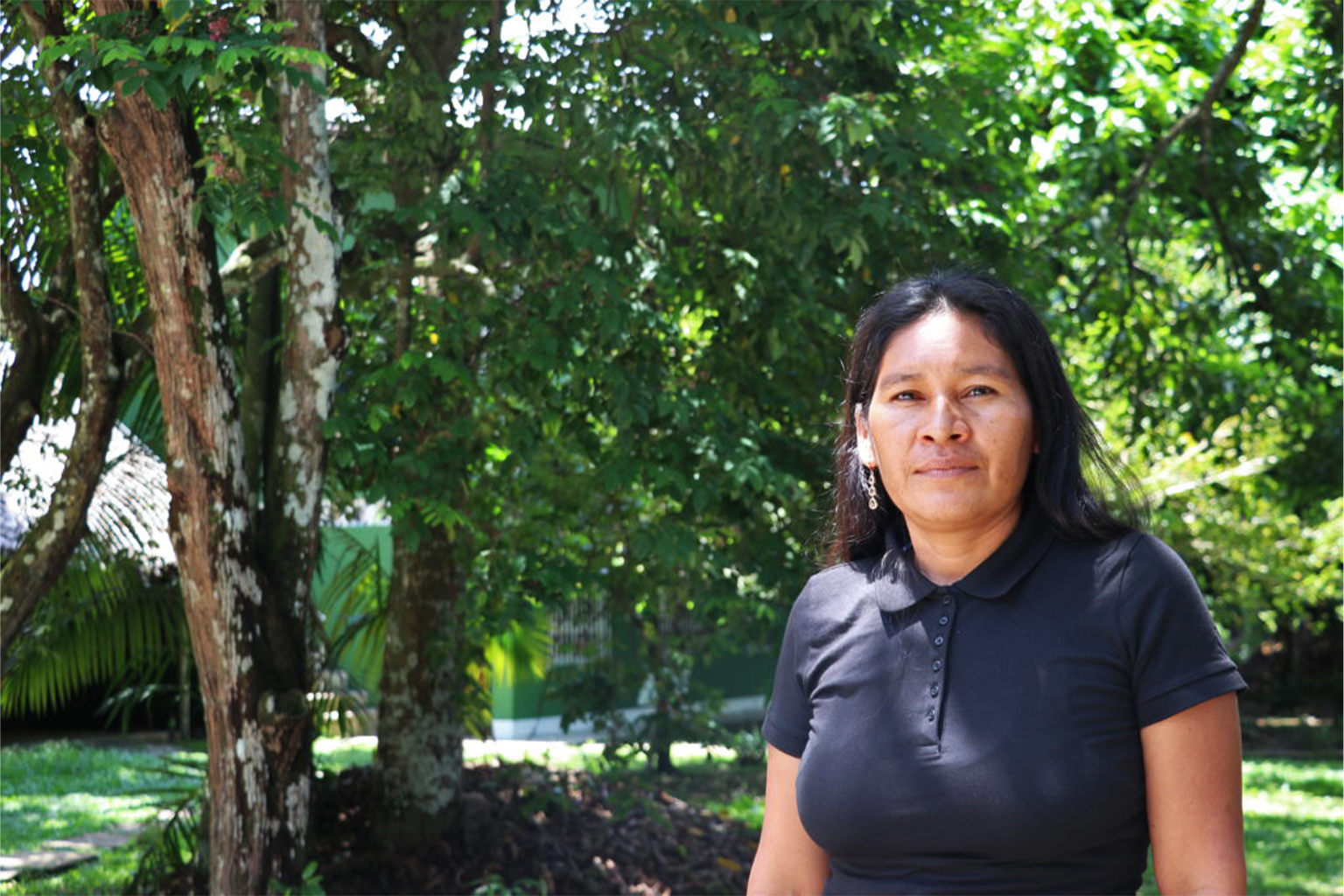
‘I can do it’
Rubio says she is proud to be descended from a long line of fighters. After being the president of the Puerto Arica community, she became a candidate to be Feconamncua’s president in 2018.
From this position, she deals directly with illegal mining, illicit coca crops and increasing deforestation in the Loreto region, as well as intimidation by wildcat miners and loggers. “They are always calling me to ask how come I reported them. I feel that there’s some risk for me,” she says. “They already know who is pressing to have them investigated and stopped.”
What pushed the 40-year-old Rubio to get involved in solving her community’s problems and to lead a federation historically run by men?
“What motivated me to take this position was seeing that no woman had said ‘I can do it,’” she says. “I remember there used to be a woman treasurer but she didn’t have the chance to speak and in the communities it was the same.”
She was also inspired by the words of her grandfather, a Kichwa man who was enslaved during the Amazon rubber boom, a time when many Indigenous peoples suffered cruel harassment. He warned that, with the passing of time, the flora and fauna they knew would disappear. “He used to say: ‘animals will be gone, the fish, the tress will be gone.’ That the more we cut the grandfather trees, with time we wouldn’t have trees to protect us from the strong winds,” she says. “I haven’t seen rosewood, and I see my grandfather was right.”
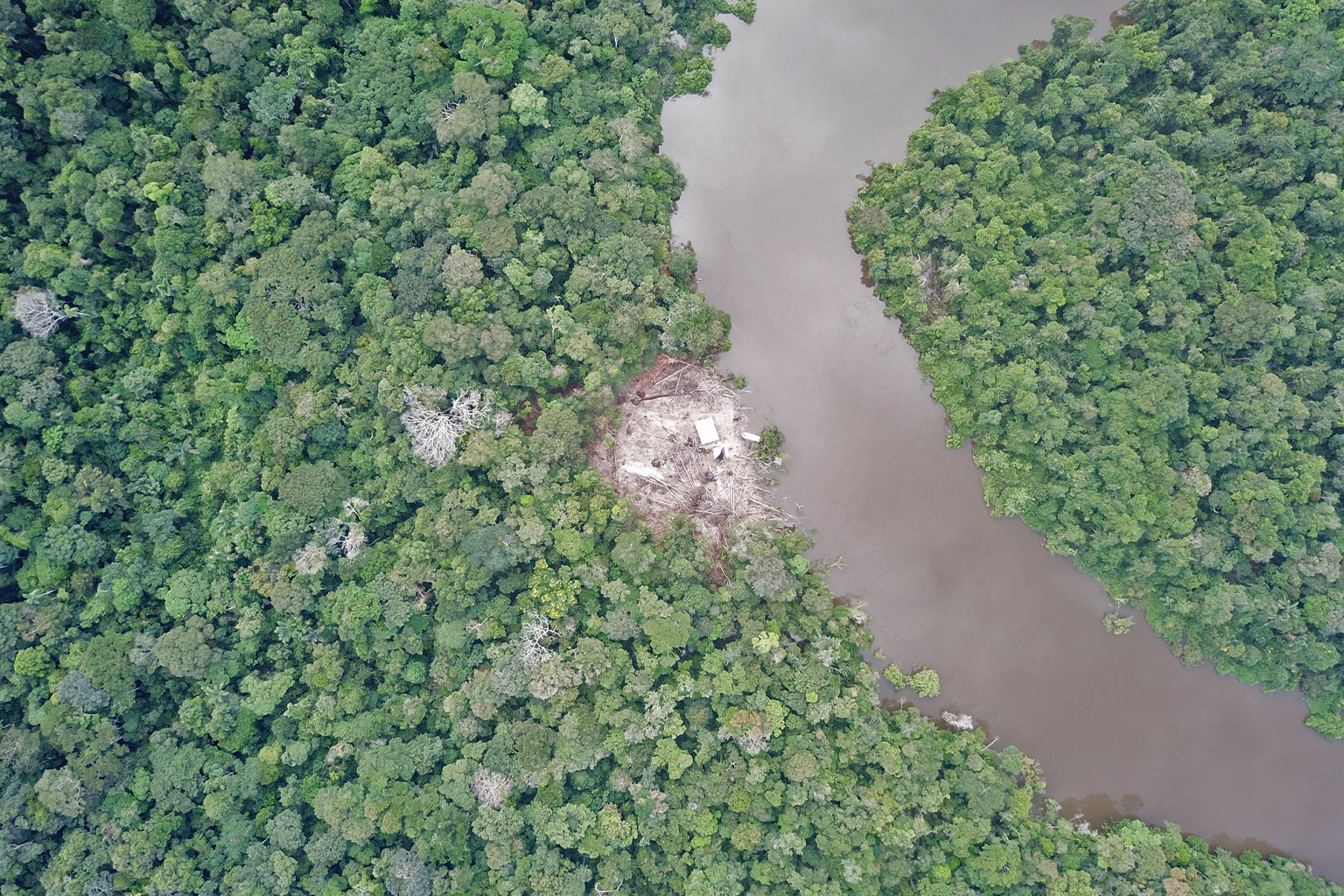
Despite the COVID-19 pandemic and its serious consequences, like the deaths of more than 148 Amazonian Indigenous people (Indigenous federations estimate the number is much higher) and the increase in illegal activities, Rubio has continued traveling within the communities she represents to collect information and provide help.
She also had to leave her home in Puerto Arica and move to the capital of her district, which is three hours away from her village by boat, for her children’s education. In 2020, classes were cancelled and online education became impossible in places with no access to internet or phone service. “At the beginning, it was very hard because they only wanted to go back to the community, but little by little they got used to it,” she says.
For Tom Bewick, director of Rainforest Foundation US (RFUS) in Peru, an NGO that leads a environmental monitoring program based on technology in Loreto since 2018 with the Organization of Indigenous Peoples of the East (ORPIO), Betty Rubio is an exceptional woman.
“She is one of the most impressive people I’ve ever met,” Bewick said. “One of the few people who has the ability to convince a family of not working in coca [crops] and working for the community and the conservation of forests, and being in front of 500 people weekly and convincing them to work with Indigenous women.”

Monitoring from the community
Bewick first met Rubio during an environmental monitoring project implemented in 36 communities in the Amazon and Napo river basins. She was one of the five women in a group of 130 people chosen by the communities to participate as environmental monitors. Her fast learning process made her an Indigenous trainer for other monitors. She taught them how to use satellite maps showing deforestation on smartphones to patrol their territories and detect illegal logging.
“We let the communities choose their monitors, and although there was a low proportion of women, they did the best monitoring and reporting,” Bewick says. “It was impressive to see their professionalism and attitude.”
Every two weeks, the monitors, using smartphone apps like Global Forest Watch and Locus Pro, analyzed the deforestation alerts detected by satellites. With this information, they patrolled the territory and looked for deforestation and illegal activities, and then the Indigenous community and their authorities evaluated the data. Finally, they compiled reports presented to the authorities or law enforcement institutions.
During the process, the reports were stored in the Center for Information and Territorial Planning (CIPTO), led by ORPIO and the first data center managed by Indigenous peoples.
Rolando Rodríguez, a specialist with CIPTO, says that since 2018 they’ve built a good database with all the information gathered about early deforestation alerts. The information even prompted the Environmental Prosecutor’s Office of Loreto start investigations into illegal logging, deforestation and mining.
However, the start of the COVID-19 pandemic put an end to the environmental monitoring activities.
“At first, the work was about verifying early deforestation alerts and along the way, we determined that most of the deforestation is caused by environmental crimes,” Rodríguez says. “Now the activities are occasional and monitors are focused on reducing the threats from environmental crimes like illegal logging, burning, land invasions and narcotrafficking in their territories.”


Women who know the territory
In 2019, after measuring community participation in the forests of Loreto, a study led by researchers from Columbia University concluded that community-based monitoring and technology can reduce deforestation in the Amazon.
In June 2021, another study found that the native communities that received satellite deforestation data through smartphones witnessed 52% less forest loss than similar communities that didn’t adopt this technology during the first year. The data show that deforestation was reduced by 21% in the second year of the study.
Rodríguez remembers one of the most recent cases of illegal logging and deforestation detected by Indigenous environmental monitors. In March 2021, they registered a new deforestation hotspot in the Tamboryacu River basin after receiving an alert from the Environment Ministry’s Geobosques platform. This early detection led to an intervention in April 28 that stopped the invasion by members of an evangelical group who had settled in a protected forest. “They had entered, logged and deforested the area and they were trying to install their camp, but a law enforcement operation stopped the crimes,” Rodríguez says. “We suspect their intention was to grow coca because they’ve done it in other communities.”
This isn’t the only case of illegal activities near the Tamboryacu River. According to Rubio and ORPIO data, some Indigenous communities living in the area have been cheated by illegal loggers and have ended up involved in allegedly laundering illegal wood, for which they have been hit by big fines.


According to the Agency for the Supervision of Forest Resources and Wildlife (Osinfor), between 2011 and 2021, 266 Indigenous communities in the region of Loreto received fines amounting to more than $1.5 million.
Bewick says that although the Indigenous monitoring project is sustainable, the resources to extend it to other communities in the Peruvian Amazon are limited. He also notes that the COVID-19 pandemic has seen an increase in environmental crimes.
According to ORPIO, illegal loggers often lie to the communities and their leaders. They offer them help with land titling and expanding their territories or installing basic services so that they can get the community documents to manage the forest permissions granted by the regional government. That’s how they access protected areas to cut trees. Illegal miners don’t look for approval from the community because they settle close to the rivers, but they do offer paid work for the illegal activity.
The monitoring project has a protection protocol for monitors that tries to help them avoid illegal activities directly because that’s a role for the authorities.
In spite of that, because they are the visible face of environmental protection in this part of the Amazon, many have been intimidated by people who carry out illegal activities. “These loggers denounced some of the monitors in the Tamboryacu River basin,” Rodríguez. “Two of them have even received death threats.”


The path to empowerment
In the 2017 national census, almost 6 million Peruvians identified as Indigenous, and 52% of them were women. However, this proportion isn’t reflected in political representation and participation of Indigenous women.
In the case of campesino communities, as the government calls Andean Indigenous peoples, only 5% of the presidencies are held by women. In native communities, or Indigenous peoples from the Amazon, that figure is 4%. Betty Rubio and Zoila Merino, the first woman president of the Federation of Ampiyacu’s Native Communities, are part of this small percentage of Indigenous women who hold a leadership position.
“I’ve been a leader since 1990. I’ve held different positions and I’ve been the president of my federation twice,” says Merino, a Bora Indigenous leader who acts as the economic secretary on ORPIO’s board of directors. “It hasn’t been easy. It’s very hard for women because we have to leave our families and face the sexism in the communities and the federations. For a long time, they didn’t want to listen to women’s voices.”
By considering this reality, several Indigenous and civil society organizations have pushed for a bill to modify the General Law for Campesino Communities to establish greater female participation. This amendment, approved in 2019, says that “the managing group of a community must include no less than 30% women or men.”
“After years asking for the gender quota, we got to modify the law but native communities have their own laws,” says Melania Canales Poma, president of the National Organization of Indigenous Andean and Amazonian Peruvian Women (ONAMIAP). “To make the change, we had to present a bill, and that requires the coordination of the communities and someone who channels the Indigenous agenda, but we don’t even have representatives in Congress.”

According to the Ombudsman’s Office in a December 2019 report, “the lack of women participation in decision-making affects public policies negatively as their making and execution omit the needs of women, excluding them and relegating them even more.”
The lack of female participation and political representation exists at all levels of government in Peru. Since 2018, ONAMIAP has proposed the creation of an Indigenous electoral district to allow them to have 32 to 33 seats in Congress, in accordance with the 25.6% of the population that Indigenous peoples comprise in Peru. They also ask that their representatives be elected with gender parity and alternation, based on their own institutions and practices.
“Even Peruvians who live abroad have a 2% quota [in Congress], but Indigenous peoples don’t. Indigenous people in Peru feel this as clear racism. Our fight and our voices are not being heard,” Canales says. “It isn’t possible that they don’t give us what is ours by right, which is having seats and representatives in a Congress that is supposed to represent the whole country.” She adds that in the last two legislative terms (2020-2021 and 2021-2026), there were no Indigenous people in Congress.
In 2005, the Peruvian electoral system established a 15% quota for Indigenous peoples but only at the regional and local levels.
“It’s been [16] years with this Indigenous quota, but what we see in practice is that this mechanism failed because it divided us and our demands,” Canales says. “Political parties use us to fill their lists. That’s why we propose that Indigenous organizations and not the parties choose their representatives. That’s how Colombia does it.”


A leadership school
While this situation persists, Zoila Merino, the Bora leader, says she hopes to one day be the president of ORPIO. She says she dreams of creating a leadership school for Loreto’s Indigenous women and men. “I want more women to be aware of their capacities and have administration and public policy knowledge,” she says. “Ideally, the school would have the same proportion of men and women so that our youngsters don’t feel forced to migrate.”
Merino also highlights the great work that Betty Rubio is doing in the communities she represents, and the overall work that Indigenous women are doing in Peru.
“We are dealing with other types of violence in a society where racism, classism, sexism, colonialism or extractivism still prevail. We don’t have the same problems other women have,” Canales says. “This has to change, but the current government has a clear position. What we want is for the system to change and that’s something we [Indigenous women] have to do, as our ancestors did before.”
From her new home, Betty Rubio keeps an eye on the monitoring in Puerto Arica, fights against illegal logging and mining, looks for consultancy for the communities involved in legal processes, and plans her next visits when she will meet with other Indigenous women. “Our community is facing many problems, but the monitoring project has helped five communities to benefit through a forest conservation convention that will offer them an economic incentive for their conservation work.”
Although women Indigenous leaders are still fighting for the rights of their peoples and for women’s rights, the number of illiterate Indigenous women is much higher than that of men, according to the Peruvian Institute of Statistics. Most of them don’t have access to higher education and almost half of them did not finish primary school.
“I want to encourage women to take leadership positions. I think that’s how we can make the authorities listen to our voice. If more women get together, they will hear us better or pay more attention,” Rubio says.

Banner image: Illustration by Kipu Visual.
Citation:
Slough, T., Kopas, J., & Urpelainen, J. (2021). Satellite-based deforestation alerts with training and incentives for patrolling facilitate community monitoring in the Peruvian Amazon. Proceedings of the National Academy of Sciences, 118(29), e2015171118. doi:10.1073/pnas.2015171118
This story was reported by Mongabay’s Latam team and published here on our Latam site on Nov. 23, 2021.
Editor’s note: This story was supported by XPRIZE Rainforest as part of their five-year competition to enhance understanding of the rainforest ecosystem. In respect to Mongabay’s policy on editorial independence, XPRIZE Rainforest does not have any right to assign, review, or edit any content published with their support.








